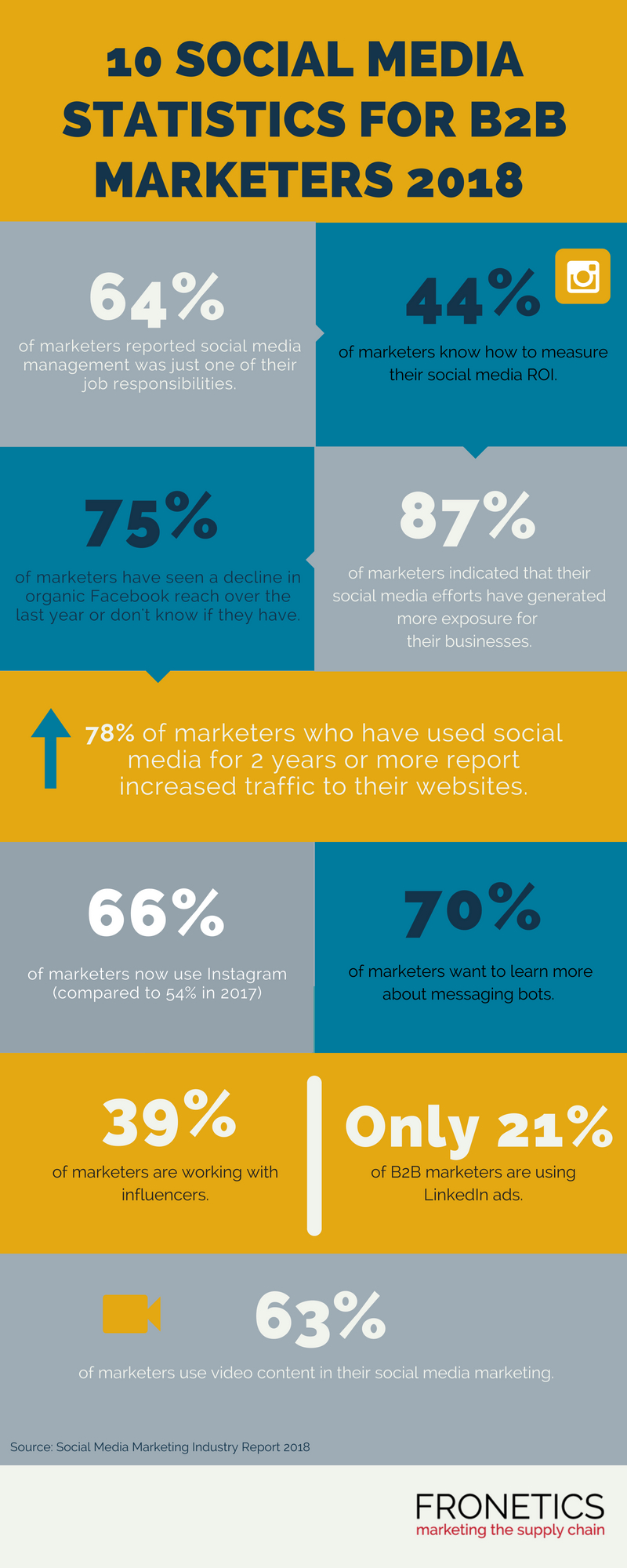
by Fronetics | Aug 23, 2018 | Blog, Content Marketing, Logistics, Marketing, Social Media, Supply Chain, Talent
Too many supply chain businesses are devoting inadequate resources and personnel to social media management.
Let’s be honest. It’s time for the supply chain to start taking social media management seriously. Even when we think we’re embracing the future, too may supply chain companies are stuck in the past when it comes to the way they think about marketing — and particularly the role of social media.
[bctt tweet=”A robust and effective social media strategy needs to be just that — a carefully designed and well-thought-out strategy, rather than simply something that an already overworked marketer adds to his or her plate.” username=”Fronetics”]
Case in point: the latest Social Media Marketing Industry Report indicates that for nearly two-thirds of marketers, managing social media marketing for their business is just one of their jobs.
Let’s think about that for a moment. That means that only one-third of the 5,700 businesses surveyed are prioritizing social media management to an adequate degree. For the other two-thirds, the vast and time-consuming task of social media management is squeezed into someone’s job description essentially as an afterthought.
If your business falls into that 64%, this is your wakeup call. Used to its fullest, social media is an immensely valuable set of tools for supply chain marketing. These platforms help brands increase visibility, establish themselves as thought leaders, attract new leads and customers, and much more.
If you’re not convinced (and you should be), take a look through Fronetics’ recent survey report on the benefits of social media for supply chain and logistics industries.
Social media management is no easy task
The thing about social media that so many businesses get wrong is that it’s not an easy task. Maybe you’re a marketer who’s been tasked with managing your brand’s social media efforts — on top of the rest of your responsibilities. It might have sounded like fun at first, essentially getting to scroll and post on Facebook for a few minutes out of the day. But chances are, you’re realizing that it’s a much bigger task than you thought.
A robust and effective social media strategy needs to be just that — a carefully designed and well-thought-out strategy, rather than simply something that an already overworked marketer adds to his or her plate.
For your business to truly take advantage of the benefits that social media can offer, you either need to devote adequate resources to it, or consider outsourcing it.
Is outsourcing right for you?
Supply chain companies are increasingly reaping the benefits of outsourcing their marketing efforts, particularly social media, as it allows them to focus on core competencies and improve productivity. As you consider trusting a professional with your social media, consider these 6 signs that outsourcing might be right for you.
The bottom line: if you’re frustrated that your social media management efforts are not as fruitful as you would like, chances are, you’re not giving them a chance. For social media to work for you, you need to devote the resources it demands — whether in house or out.
Related posts:


by Fronetics | Aug 22, 2018 | Blog, Content Marketing, Logistics, Manufacturing & Distribution, Marketing, Strategy, Supply Chain
Account-based marketing has traditionally utilized outbound marketing tactics, until now.
Account-based marketing has been around for decades, but it has been gaining a lot of attention in the past few years. More and more companies are starting to use account-based marketing to increase their brand awareness with specific audiences and work together with sales teams to close deals.
But what is account-based marketing?
Account-based marketing
Account-based marketing (ABM) is a focused approach to B2B marketing in which marketing and sales teams work together to target best-fit accounts and turn them into customers. Marketers and sales teams focus their efforts on specific accounts — companies, customers, target audiences — and work to get marketing materials in front of them.
Essentially, account-based marketing takes a potential customer and turns them into their own market. “[ABM] is to address the needs of organization by connecting with all of the stakeholders within it. That’s one reason why it works so well in B2B — oftentimes you have to work with five or more stakeholders in a given sale,” writes Sam Balter, HubSpot’s Corporate Marketing Manager.
So how can content marketing help with ABM, which has traditionally been a sales strategy?
Content marketing and account-based marketing
Inbound marketing focuses on audiences finding you. Instead of pushing a message onto buyers, inbound marketing allows you to establish your brand as an industry leader and let interested audiences come to you. This type of marketing attempts to draw in potential customers through interesting and engaging content.
Content marketing is a type of inbound marketing that uses blog posts, social media, infographics, and video to expose target audiences to a brand.
Merging sales and marketing efforts
There’s no reason that ABM and content marketing can’t work together. In fact, you’re missing out on maximizing your marketing efforts if you aren’t incorporating both of these marketing strategies in your overall marketing plan.
[bctt tweet=”Traditional sales pitches are no longer pushing buyers down the sales funnel. Instead, buyers want a personalized experience, where they feel they are getting to know a brand before they make a buying decision.” username=”Fronetics”]
Today’s buyers don’t want to be ‘sold.’ Traditional sales pitches are no longer pushing buyers down the sales funnel. Instead, buyers want a personalized experience, where they feel they are getting to know a brand before they make a buying decision.
What does this mean for your ABM strategy? It means that content marketing can help educate and inform the specific accounts your sales team has identified through valuable, interesting content.
“For example, if you approach any content you create as part of the strategy with both goals in mind, you can create a piece of content that is both incredibly useful from a keyword perspective (and drives a ton of traffic to your site) while also providing all the key information that you’d like to say to your ABM contacts,” writes Stacy Willis for Impact.
When creating content for any marketing effort, the key is to make sure that your content has value. Whether you’re trying to attract a specific account or looking to increase web traffic, content marketing focuses on value and not just volume.
Creating a cohesive account-based marketing and inbound marketing strategy will help maximize your marketing efforts. Though not traditionally used together, it’s time to think outside the box and start seeing the benefits of a joint marketing approach.
Related posts:


by Fronetics | Aug 21, 2018 | Blog, Content Marketing, Leadership, Logistics, Marketing, Supply Chain
Here are three warning signs that you may be a toxic leader and how you can make changes to avoid these damaging behaviors.
Let’s face it: As the leader of a company, region, or even a team, you have the power to influence those that report to you. This can be a great asset to teams governed by leaders that pride themselves on hard work, respect, and open communication.
But what about a leader that does the exact opposite? A leader whose behavior creates a negative, possibly even hostile, working environment?
Toxic leader: who are you?
A toxic leader is defined as a person who has responsibility over a group of people or an organization, and who abuses the leader–follower relationship by leaving the group or organization in a worse condition than when they first found them.
It’s easy for toxic leaders to blame poor performance and low morale on individuals within the team. But, at some point, it’s important to see if the way employees are managed is a direct reflection of their leadership.
Here are three warning signs that you might be a toxic leader and how to fix the behavior.
3 signs you’re a toxic leader
1. Scattered priorities
This type of toxic leader is an expert in failed time management. Leaders that are unable to prioritize tasks and allow employees to focus on getting their work done are really working to waste their most valuable resources: their trained team.
A recent survey conducted by consulting firm RHR International showed that among high-performing leadership teams, 93% are able to prioritize the most important issues and 96% focus on the right issues. But in low-performing leadership teams, only 62% prioritize well and 53% are focused on the right issues.
Change: Leadership that calls meetings without a set agenda, leaves issues unresolved, and veers off topic when met with questions needs to sit down and start to focus. Toxic leaders that find themselves with scattered priorities can easily get back on track by creating lists that document daily, weekly, and even monthly tasks. Work with your team to delegate tasks and create solutions to issues, and then give them the space to work on their assignments.
2. Unhealthy rivalries
The overly competitive leader with an eye on perfection often has a ‘winning is everything’ attitude, even if comes at the detriment of their team. This toxic leader doesn’t mind leaving broken employees on the sidelines if it means getting ahead.
[bctt tweet=”The overly competitive leader with an eye on perfection often has a ‘winning is everything’ attitude, even if comes at the detriment of their team.” username=”Fronetics”]
In reality, instead of getting ahead, these toxic leaders create a hostile work environment, where employees lose interest in their jobs due to unobtainable demands and a lack of trust in their leadership.
Change: Leadership, and the rest of their team, must work as a unified team. “Shared goals must be accompanied by shared accountability,” writes Ron Carucci, co-founder and managing partner at leadership consulting firm Navalent, for Harvard Business Review. Remove the unnecessary competition from the workplace, and focus on dividing and conquering so everyone is doing their best and achieving their best.
3. Unproductive conflict
When conflicts arise, and they are most certainly going to, leaders need to step in quickly and efficiently to resolve the situation. When organizations have leaders that create or improperly handle conflict, the rest of the team follows their lead.
These leaders often have a reason or excuse for any issues that arise and rarely take responsibility for their role in the matter. With high confidence in their abilities, toxic leaders with unproductive conflict often believe they are right and surround themselves with people that won’t challenge them.
Change: Leadership needs to have certain behaviors that absolutely will not engage in: speaking negatively about team members or other employees or withholding feedback or suggestions that will positively impact their team. If you can relate to any of these points, sit down and write out behaviors that you will no longer engage in. Distribute this list to your team and regularly assess how you’re doing with your list and where you need to personally make tweaks.
What are some other sign of a toxic leader?
Related posts:


by Fronetics | Aug 20, 2018 | Blog, Content Marketing, Logistics, Marketing, Strategy, Supply Chain
Here’s a breakdown of the latest findings regarding the best time to send an email and what we recommend for getting the most of out of your email marketing efforts.
We are all inundated with daily emails. Whether it’s work emails, special offers from brands you love, or straight-up spam email, we all have inboxes full of emails – most of which will never be opened.
But, on the flip side, “email is the third most influential source of information for B2B audiences, behind colleague recommendations and industry thought leaders,” reports WordStream.
So how do you get your emails to stand out in cluttered inboxes? How do you get readers to actually open — and scroll through — your thoughtfully crafted content?
At Fronetics, we believe there isn’t a one-size-fits-all answer to what works best for email marketing. In order to be successful, you need to take into consideration:
- Who is your target audience?
- What job titles do they hold?
- What kind of devices do they use?
- When are they commuting to work?
Taking a look at the schedules and habits of your target audience will give you insight into the optimal times for readers to engage with your emails. Here’s Jennifer Hart Yim, director of strategy at Fronetics, with a look at what we recommend when trying to find your optimal time to send marketing emails.
[bctt tweet=”Taking a look at the schedules and habits of your target audience will give you insight into the optimal times for readers to engage with your emails. ” username=”Fronetics”]
Video: When is the best time to send an email?
Takeaway: Trial and error
As with most aspects of content marketing, there’s no universal answer to the best time to send marketing emails. The only way to truly know what works best for your company is trail and error. You’ll have to test dates and times to find the best time to send an email your target audience.
But keep in mind that there are other factors, aside from date and time, that affect open and click-through rates. You’ll also have to play around with frequency, subject lines, length of emails, and the overall look and feel of your email.
Have you tested your best time to send an email? What worked for your company?
Related posts:


by Fronetics | Aug 16, 2018 | Blog, Content Marketing, Data/Analytics, Logistics, Marketing, Social Media, Supply Chain
The latest social media statistics show growth of Instagram, more metrics for ROI, social messaging bots, and video content.
One thing that always holds true with social media platforms: they are constantly changing. Platforms like Facebook, Instagram, and Twitter have used 2018 to continue this trend of continual growth and improvement.
[bctt tweet=”One thing that always holds true with social media platforms: they are constantly changing. Platforms like Facebook, Instagram, and Twitter have used 2018 to continue this trend of continual growth and improvement.” username=”Fronetics”]
It’s important with all the changes to take a pause and analyze where these changes are taking us. Simple data can point us to the latest trends and show us where social media is heading.
Social Media Examiner’s 10th annual study, 2018 Social Media Marketing Industry Report, surveyed more than 5,700 marketers from across the world in a variety of industries to see how social media is changing. It offers a really comprehensive view of what’s going on in social media in our industry and beyond.
“This industry report also shows you how marketers’ organic activities have changed and what their future plans are with organic and paid social media,” write the report’s authors.
Here are 10 social media statistics from the report that reflect where social media is headed and what B2B marketers need to be paying attention to.
Infographic: 10 social media statistics for B2B marketers 2018

(Made with Canva)
Still want more?
I really recommend reading the 44-page report in its entirety from Social Media Examiner. There are pages and pages of interesting social media statistics that offer valuable insight into how marketers from all industries are using social media.
The report also shows how social media has changed in the last few years and even more rapidly in the past few months. With messaging bots and video content on the horizon, it’s hard not to wonder where social media will take us next.
What social media statistics are most interesting to you?
Related posts:


by Fronetics | Aug 15, 2018 | Blog, Customer Service, Data Security, Data/Analytics, Logistics, Strategy, Supply Chain
Data breaches are all over the news lately, but data analytics may be the key to tighter security — and better customer service.
A growing number of high-profile organizations have been in the news recently for data breaches that put customers at risk, and the trend shows no signs of stopping. Collecting data about customers allows organizations the advantage of personalizing their services, but safeguarding that data comes with major security concerns.
[bctt tweet=”Collecting data about customers allows organizations the advantage of personalizing their services, but safeguarding that data comes with major security concerns.” username=”Fronetics”]
Data analytics, or the way organizations process the information they collect to learn about their customers, is becoming increasingly effective at de-anonymizing large amounts of data and tying it back to specific individuals. While personalized data is a goldmine in terms of marketing and services, it’s also exactly what cyber-criminals target.
But information expert Sam Ransbotham, in the MIT Sloan Management Review, says that de-anonymizing people through data analytics coud be a powerful security tool itself, and can even improve customer service along with way.
How data analytics plays into security
Ransbotham points out that authenticating identity is one of the most important parts of keeping data secure. Whether online or over the telephone, authenticating your identity usually means answering a string of questions first to identify your account and then to affirm that you are who you say you are.
Data analytics, however, offer a better way of authenticating identity. A number of companies in the banking sector have already begun to use speech processing to identify a caller’s voice based on recordings of previous telephone calls. These “voiceprints” can confirm identity almost instantly and reduce the chance of someone stealing a personal identification number (PIN).
Using an automated system of voice-data analysis gives banks the added benefit of being able to adjust their security protocols for all customer service interactions at once. This allows for faster responses to updated assessments of security threats, rather than having to re-train customer service representatives.
Customer service advantages
Instead of making callers identify themselves by answering “security challenge questions,” data analytics allows the security process to take place behind the scenes. Customers experience a more streamlined calling experience that immediately addresses their needs. They save time and are spared the hassle of answering questions to identify themselves.
Security challenge questions are, Ransbotham says, “adversarial by design. … This authentication process must begin with the assumption that the caller is a malefactor impersonating the real customer.” By performing the authentication process behind the scenes, voiceprints help re-define the customer service experience as helpful instead of combative.
Organizations, in turn, can save time on employee training. They can focus on training employees for service rather than security.
Data analytics does not have to involve a trade-off between security and service. Techniques like collecting and analyzing voice data can actually start providing solutions to some of the security concerns that data collection raised in the first place.
As Ransbotham suggests, data analytics has the potential for further applications. Voice analysis can detect speech patterns that indicate if someone is being coerced or suffering from impairment, which could be adapted for security and service purposes, too.
Related posts:














